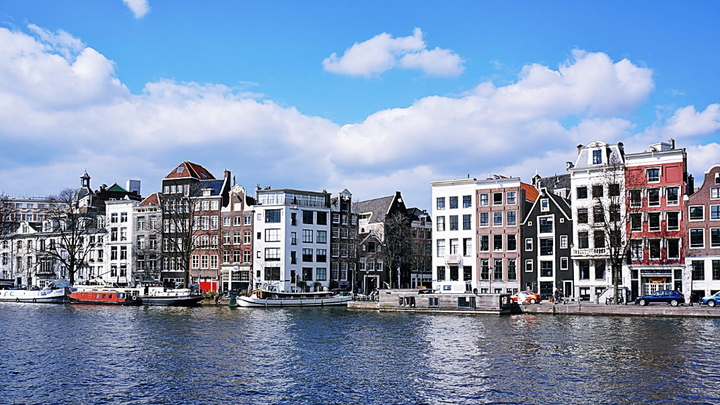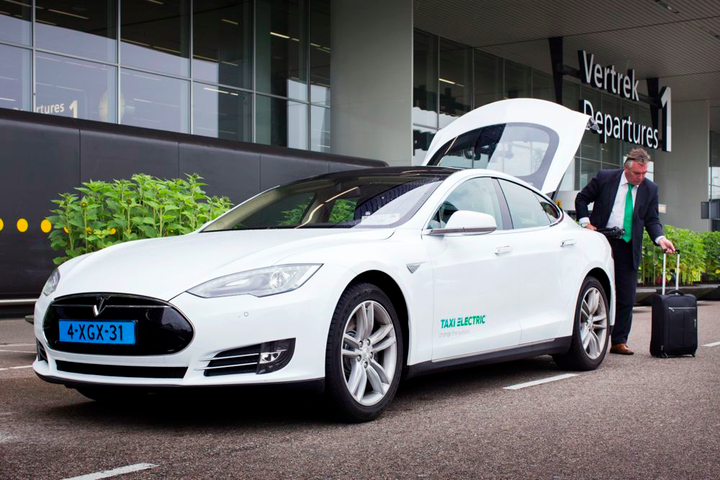First of a four-part series on Amsterdam’s efforts to reduce its carbon footprint and become a more sustainable city. The preceding overview article on sustainability efforts in the Netherlands can be found here.

Amsterdam, The Netherlands — Knowing that a large and increasing share of global greenhouse gas (GHG) emissions come from cities, and that the world is currently projected to warm 4 degrees Celsius by 2100, if not sooner, it is clearly imperative to reduce cities’ GHG emissions.
Cities account for 71-76 percent of global GHGs and a large fraction of the world’s population will live in cities by 2050. (The Global Commission on the Economy and Climate puts the number at 85 percent; the UN Department of Economic and Social Affairs puts it at two-thirds of the total.)
To get a better understanding of how leading European cities are planning to reduce their GHGs and accommodate to climate change, I traveled to Amsterdam (as well as Rotterdam, Ghent, Copenhagen, and Stockholm) in November 2015 to learn more about their successes and struggles.
Reducing cities’ GHGs to protect the climate may sound like a straightforward, linear process. Just set municipal targets, conduct appropriate studies, create policies, apply them, and watch emissions fall. Amsterdam’s experience as a front-runner in the global race to reduce GHGs, however, reveals that reality is messier
Reaching for Sustainability
To achieve its sustainability plans, the city is collaborating and seeking agreements with industries, supply chain managers, real estate developers, and its bus and taxi companies. It has also established a revolving Sustainability Fund of almost €50 million in addition to an existing €40 million in the city’s Climate and Energy Fund. Organizations needing low-interest loans for sustainable energy projects or for waste reuse-and-recovery efforts, can apply to the new fund.
Through various programs, the city’s energy and environmental agenda, Sustainable Amsterdam, calls for increasing per person renewable energy production 20 percent from 2013 to 2020 while increasing the city’s installed solar energy capacity from 9 MW to 160 MW and reducing overall per person energy use by 20 percent.

The city is also planning on an 18 MW increase in its installed wind power capacity by 2020―up 27 percent over current levels. (For more on that, watch for “Wind Energy Challenges in the Netherlands,” Huffington Post, forthcoming.) By then, the city plans to improve its air quality by reducing soot emissions by 30 percent and nitrogen dioxide concentrations by 35 percent.
Challenges Remain
While the city is, in general, making good progress on its agenda, some things are somewhat behind schedule. The city government had planned to be energy-neutral by 2015, but hasn’t yet succeeded.
After the goal was established in 2007, not enough money was initially allocated to retrofit the hundreds of city-owned buildings (29 percent of municipal CO-emissions), or replace 110,000 existing streetlights (45 percent of emissions) with dimmable LED-lights. Thus the goal was postponed in 2013.
Progress toward the goal has increased since last year, however, and the municipality is now on track to reduce its emissions by 45 percent in 2025 (compared with 2012).
The city also had planned to increase its solar generating capacity to 25 MW by 2016 but is only at 16 MW. (That’s still a 78 percent increase over 2013.) And whereas the city was going to drive 2016 per capita energy consumption down by 15 percent, it has only managed to reduce it by six percent relative to 2013.
Electric Transport
Despite these quibbles, lots of good things are being accomplished in Amsterdam, and many ambitious, innovative programs are underway.
To stimulate electric vehicle (EV) demand to reduce air pollution, Amsterdam is increasing the number of its public EV charging stations from 1,000 in 2013 to 4,000 by 2018. (The city currently has 1,900 regular public charging stations and roughly an equal number of private charging points.) There are also fast chargers for taxis.

Vehicle owners in Amsterdam who buy an electric car get a public charging outlet in front of their house, and the city plans to give EV drivers more privileges, such as allowing them to deliver goods to stores during hours when deliveries by fossil-fueled vehicles are restricted.
Whereas the city’s taxi and bus companies originally were strongly opposed to the city’s climate and energy program, the city has successfully enlisted the cooperation of both groups. It reached an agreement with its municipal bus company in 2015 to have all-electric bus transport by 2025 and is studying how its municipal ferries can be made cleaner.

In addition, the hundreds of mostly diesel boats now used for tours through the city’s historic canals have to be electric by 2025.
The city also reached an agreement with its taxi fleet: All taxis within the city will have to be electric by 2025 and, during the transition, electric taxis are getting preferential treatment at certain city taxi stands, so they have to wait less for their fares, making the switch to electricity more profitable.
As part of a deal with delivery companies, Amsterdam will also increase the number of freight transfer hubs on the outskirts of the city. There, gasoline and diesel-powered commercial vehicles are encouraged to transfer cargo to low-emission or zero-emission vehicles and to combine loads to reduce the number of delivery trucks in the city.
Waste-to-Energy
Over the seven years from 2013 to 2020, the city intends to increase the number of homes connected to district heating from 62,000 to 102,000 and to provide an €8 million subsidy to one of the city’s public housing corporations to retrofit 1,000 apartments to a zero-net-energy standard. The city hopes that this program will encourage other building owners to follow suit.
Amsterdam’s solid waste is burned in an incinerator to produce heat and power for the city. The electricity goes into the grid, and the heat is distributed to residential and industrial customers. Although the plant burns municipal waste, the city is nonetheless seeking to increase the separated percentage of its solid waste from 19 percent in 2013 to 65 percent in 2020.
Peter Paul Ekker, a spokesman for Amsterdam Alderman (and vice mayor for sustainability) Abdeluheb Choho said that in Amsterdam, there is unanimous support for greening the city and making it more sustainable, “especially since we now also see that it brings new jobs, new wealth, [and] new business opportunities.”
Amsterdam is one of the world’s most politically progressive, socially cohesive, and technologically advanced cities. So the challenges it has encountered in moving toward sustainability should serve as a cautionary tale. Less developed, less well-governed, more fractious societies face far greater obstacles on their paths toward eventual sustainability.
Developing nations are increasing their GHG emissions rapidly today, typically at 5-6 percent per year. These countries and their large, rapidly growing cities, tend to be less homogeneous, less affluent, and less orderly than Amsterdam and other Western European capitals. Their challenges will likely be far greater than those Amsterdam has encountered.
#
–––––––––––––––––––
First of four parts concerning sustainability efforts in Amsterdam. In Part 2, the focus is on the quality of life and economic benefits that ambitious solutions to climate problems offer the citizens of Amsterdam.
Other articles in the Netherlands sustainability series include:
‒ Sustainable Amsterdam, Part 2—Mobilizing for A Clean, Prosperous Future
‒ Sustainable Amsterdam, Part 3—Ambitious Electric Mobility, District Heating, and Circular Economy Goals
‒ Sustainable Amsterdam, Part 4—Port Embarks on a Clean Energy Transition
‒ Wind Energy Challenges in the Netherlands.
___________________
John J. Berger, PhD. (www.johnjberger.com) is an energy and environmental policy specialist who has produced ten books on climate, energy, and natural resource topics. He is the author of Climate Peril: The Intelligent Reader’s Guide to the Climate Crisis, and Climate Myths: The Campaign Against Climate Science, and is at work on a new book about climate solutions.
Follow John J. Berger on Twitter: www.twitter.com/johnjberger
